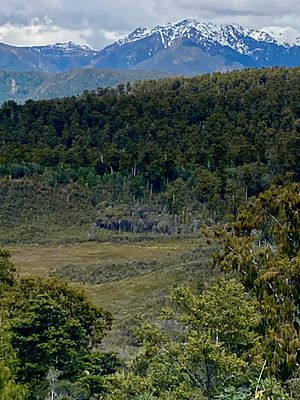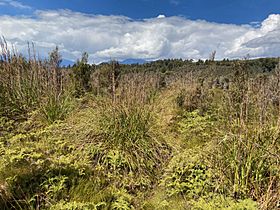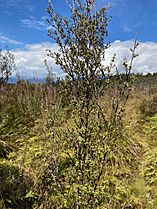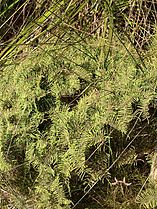Pakihi facts for kids
Pakihi (pronounced PAH-kee-hee) is a special type of land found only on the West Coast of New Zealand's South Island. It's usually flat and boggy, with very poor, wet soil. Only certain plants like rushes, ferns, moss, and mānuka trees can grow there.
Contents
What's in a Name?
The Māori word pākihi has a few meanings. It can mean "open country" or "barren land," which describes how pakihi areas look. It can also mean "a clearing in a forest" or "a place where fern roots were dug up." These meanings fit well because pakihi land is often open, and sometimes it was created after forests were cleared.
Where Can You Find Pakihi?
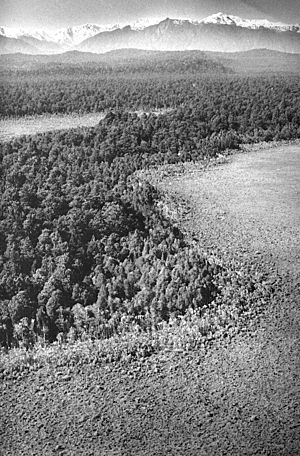
Pakihi areas stretch for about 540 kilometers along the west side of the South Island. You can find them from Golden Bay in the north down to Awarua Bay in the south. They are very common in the central West Coast, between Westport and Hokitika. Most pakihi areas are near the coast, but some can be found up to 50 kilometers inland.
Some pakihi areas are naturally formed and have existed for thousands of years. For example, the Dismal or Sponge Swamp near Haast has peat (decayed plant matter) that is 10,000 years old! The soil in these areas is very wet and doesn't have much oxygen. This can stop old pollen and wood from decaying, allowing scientists to study ancient forests.
Other pakihi areas were created by people. When early European settlers cleared forests on the West Coast, the land sometimes became very wet and infertile. Regular fires also stopped new forests from growing back, leading to pakihi vegetation. The first Polynesian settlers and later Māori also created pakihi sites by clearing land. It's often hard to tell if a pakihi area was created by humans or if it formed naturally.
Why is Pakihi Soil So Different?
Pakihi areas are almost always flat or gently rolling. They usually form on plains and terraces made from sediment left behind by melting glaciers. These terraces can be very old, from 10,000 to 250,000 years old.
The soil in pakihi areas is very poor and acidic, with a pH of less than 4.5. It's also extremely wet because these areas get more than 2200 mm of rain each year. The constant water washes away most of the important nutrients.
Sometimes, a hard layer called an "iron pan" forms under the soil. This layer stops water from draining away, which can "drown" forest trees. Only tough plants like ferns, moss, and scrub can survive. Even without an iron pan, any soil conditions that keep the ground waterlogged can lead to pakihi.
What Plants Grow in Pakihi?
Pakihi areas have a special mix of plants that can handle the wet, poor soil. Here are some common ones:
- Mānuka (Leptospermum scoparium)
- Inanga (Dracophyllum longifolium)
- Upright cutty grass (Gahnia rigida)
- Tangle ferns (Gleichenia dicarpa, G. microphylla)
- Pakihi rush (Baumea teretifolia)
- Wire rush (Empodisma minus)
- Wiwi (Juncus gregiflorus)
- Square sedge (Lepidosperma australe)
- Red tussock (Chionochloa rubra)
- Sphagnum moss
You might also find orchids (like Thelymitra pulchella), sundews (Drosera), and mountain flax (Phormium colensoi). Around the edges of pakihi areas, you'll see mānuka, mountain toatoa (Phyllocladus alpinus), and silver pine (Manoao colensoi). These plants then blend into swamp forests with rimu (Dacrydium cupressinum) and kahikatea (Dacrycarpus dacrydioides) trees.
The types of plants in a pakihi area depend on how long it's been since a fire, the climate, and how old the glacial terrace is. Many pakihi areas are slowly changing. Most of them, except for the very wettest parts, will eventually turn back into forest if left undisturbed.
Farming Pakihi Land
When Europeans first settled the West Coast, pakihi land seemed perfect for farming. There were no forests to clear! However, it was much harder than it looked to drain the flat, rainy land and grow grass. Many attempts to farm pakihi were given up because it was too difficult.
For many years, farmers tried different ways to make pakihi land productive. They experimented with different grasses, adding lime, lots of fertilizer, and even using explosives to break up the iron pan. In the 1920s, the Cawthron Institute tried to "reclaim" pakihi land near Westport. They turned over 1,100 acres into dairy pasture in the 1930s, but it wasn't very successful.
Today, pakihi can be turned into pasture by using a digger to "flip" the top two or three meters of soil. This breaks up any hard layers and helps water drain. Another method is "humping and hollowing," which creates raised beds for plants. Both methods need a lot of fertilizer, like superphosphate, for many years to improve the soil.
One problem with changing pakihi land for farming is that it can lead to huge outbreaks of pests. When the land is cleared, insects can multiply very quickly because their natural enemies are gone. For example, after "flipping" land at Cape Foulwind, mānuka beetle larvae (Pyronota festiva) increased from about 80 per square meter to over 3500 per square meter!
Sphagnum moss, which is common in pakihi, is now harvested on the West Coast. It's exported for use in gardening and for growing indoor plants.
Why is Pakihi Important to Protect?
A big threat to pakihi areas is farming, especially with more dairy farming in New Zealand. As technology made it easier to develop pakihi land for farming or forestry in the 1970s, people started calling for its protection.
Pakihi swampland is a very important home for the fernbird, especially where there is mānuka scrub at least 2 meters tall. Some pakihi areas have been set aside as special reserves to protect them.
Sometimes, pakihi reserves need to be regularly burned. This helps low-growing herbaceous plants survive and stops mānuka scrub from taking over. However, fernbirds prefer the low, bushy plants that would be destroyed by fire, so managing these areas can be tricky.


